The Heart of Serbia
THROUGH KOSOVO, LENGTHWISE AND CROSSWISE (2)
Wisdom of the Sanctities Guardians
We have been there, seen almost everything, with a deep and clear feeling that we were walking upon our own country. Homeland. And? After that, one feels more dignified and more of a human. We watch the landscapes, this earth and this sky, those cities and temples, those people, sort the memories, and some unusual peacefulness fulfils us. We know that we will come back. This bashi-bazouk also knows it with its unmistakable cowardly heart. That is why they so desperately need our consent that we will never go back there again. That is why they will never get it. Two different times are before them and us. Each must live through its own. Until the time for sewing together comes
By: Branislav Matić
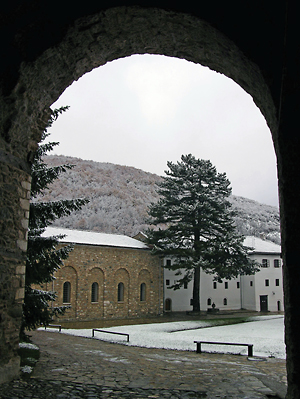 We pass through Dečane, a small town on the road between Peć and Djakovica, at early dusk. The sky is low, rain is pouring, the darkness is already heavy and thick. The weak lights, most of them from numerous shops packed one by another, overloaded with the same goods, can hardly be seen in this darkness. There is not a single Serb left in this town. Not a single ”non-Albanian”. The international administration can now calmly inform: ”There are no more inter-ethnic incidents and tensions in Dečane. This proves the decisiveness and effectiveness of the international community, the fulfillment of the mission and achieving European standards.” We pass through Dečane, a small town on the road between Peć and Djakovica, at early dusk. The sky is low, rain is pouring, the darkness is already heavy and thick. The weak lights, most of them from numerous shops packed one by another, overloaded with the same goods, can hardly be seen in this darkness. There is not a single Serb left in this town. Not a single ”non-Albanian”. The international administration can now calmly inform: ”There are no more inter-ethnic incidents and tensions in Dečane. This proves the decisiveness and effectiveness of the international community, the fulfillment of the mission and achieving European standards.”
In the center, by the crossing with a rotary, stands a small road sign in Serbian, in Latin letters: Visoki Dečani, right. Several kilometers up by the Dečani Bistrica, by a road ending in the bosom of the mighty mountains, we arrive near the Visoki Dečani monastery. First, a powerful concrete obstacle rises on the road, placed by the Italian soldiers from the KFOR. The visitor is forced to drastically decrease speed. Then a well armed soldier approaches. The control is detailed and rigid. They forbid taking pictures, speak as little as possible, with their arms within reach. Documents, consultations with someone from the monastery, checking whether the visit is previously announced. The Italians (according to our impression) won’t speak English, and our knowledge of other languages doesn’t overlap, so we improvise. And improvisation is our strong point, both theirs and ours.
In the tragic March of 2004, when the greatest Serbian sanctities were burning throughout Kosovo and Metohija, they, the Italian soldiers, were the ones who preserved Visoki Dečani. There is a story that the then commander of their contingent, the Italian general, drew a line on the road leading from the town of Dečane to the monastery and said:
”The one who crosses this line will be liquidated without warning!”
Nobody crossed it.
In many other places, and in the same zone of responsibility, no one drew lines. Many Orthodox sanctities are gone, including the fifteen ones from the XIV and XV century, Serbian villages are erased, and even the graves of their inhabitants are unknown. We have seen sites of fire, ruins, desolation. These are the images we carry in our eyes from our today’s journey through noble Metohija.
Under the continuously pouring rain, we enter the yard of Visoki Dečani. One doesn’t have to be a believer to feel, physically, the power of this holy place. That shudder, that excitement, that unusual mixture of shocking joy and fear of God, cannot be overlooked, cannot be mixed up with anything else. We know many people in whose lives Visoki Dečani meant a turn of fate. There are many Italian soldiers who remained eternally and most deeply attached to the Monastery, some of them changed their religion into Orthodoxy here. We think about them while we shake off the rain and climb up the wooden stairs of the Archimandritry. As always, they welcome us with joy and open-heartedly.
ALL PATHS LEAD UPWARDS 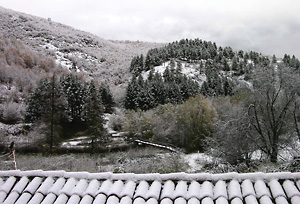 The construction of the Dečani temple, dedicated to the Ascension of Christ, a pearl of Serbian medieval architecture, was commenced in 1327 by king Stefan Uroš III Nemanjić, named after this place Stefan of Dečani, as his burial church. It was completed in 1335 by his son Dušan, the most powerful Serbian monarch in the Middle Ages. So much has been written, sung, noted by a painting brush, stone, camera, about the beauties of this temple. The construction of the Dečani temple, dedicated to the Ascension of Christ, a pearl of Serbian medieval architecture, was commenced in 1327 by king Stefan Uroš III Nemanjić, named after this place Stefan of Dečani, as his burial church. It was completed in 1335 by his son Dušan, the most powerful Serbian monarch in the Middle Ages. So much has been written, sung, noted by a painting brush, stone, camera, about the beauties of this temple.
The fraternity is at the evening service. Today is Friday, and no lights are turned on in the temple, except the candles. How to describe that unearthly feeling when you stand in the semi-darkness of a temple illuminated by candles, above the reliquary with the miraculous relics of the holy king, while the singing of the monks rises from all sides, and only the murmur of rain and deep silence of the long Metohija night comes from the outside? How to try to explain what you are just beginning to understand: how insignificant the fact of external seizure and terrible earthly loneliness is in that moment, since, from Visoki Dečani, all paths lead upwards?
”Who is able to speak of God’s power?” says the Foundation Decree of the Visoki Dečani monastery, from the XIV century. ”Our fathers loved Him and trusted in Him, trusted and were salvaged, since, rejecting the worries of everything earthly and accepting spiritual senses and fear of God, they replaced the earthly empire with heavenly life and infinite glory, leaving us praiseworthy memories on earth.”
Being here is a first-class spiritual experience. That experience and the great, exciting Dečani story of suffering, martyrdom and victory will be told separately, in some future occasion.
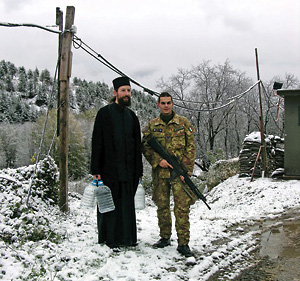 An evening spent in conversation with bishop Teodosije, prior of Visoki Dečani and the Vicar Episcope of Lipljan, and the wonderful monks of Dečani. For centuries, the Dečani monastic community, besides martyrdom and gentleness, has been graced with education and creativity. And a kind of peaceful beyond-timely joy, chaste and illuminating, which has saved the world and life so many times. An evening spent in conversation with bishop Teodosije, prior of Visoki Dečani and the Vicar Episcope of Lipljan, and the wonderful monks of Dečani. For centuries, the Dečani monastic community, besides martyrdom and gentleness, has been graced with education and creativity. And a kind of peaceful beyond-timely joy, chaste and illuminating, which has saved the world and life so many times.
Now, as it used to be before.
In the year 1992, with the blessing of Bishop Artemije, seven young monks from the Crna Reka Monastery came here, led by the present prior and Bishop Teodosije. They came to help the older brothers in Dečani and started a great flourish of this sanctity. The fraternity has multiply increased, and Dečani, as centuries ago, still gathers elite monks, able to perform greatest feats and greatest endeavors.
The Bishop speaks calmly and deeply, with wisdom which is perhaps only gained in this ”wondrous place in horrible surroundings”. With the wisdom of a Sanctity Guardian who knows how to survive in such a place and how to outlive ruffians. With the wisdom which knows that nothing starts and nothing ends with us. Those who are leading the country in these difficult times could learn a lot from him.
The Bishop shows us an excellent edition of books about the Monastery, made by the monks, extraordinarily illustrated and equipped like the best international publications of such type, printed in Serbian, English, Italian and French. They are preparing publications in several other languages, including Albanian. In the Dečane Archimandritry, in the computer center, we talked to father Sava (Janjić) and the monks performing this ”electronic chore” until late into the night. Some of the most important Serbian projects on the internet were initiated from that very place, as well as numerous actions in the worldwide network. When all the other sources would become silent, when all the other lines would be cut, the truth in words and images from here reached the most distant places of the planet.
ABOVE THE RELICS OF HOLY ANCESTORS 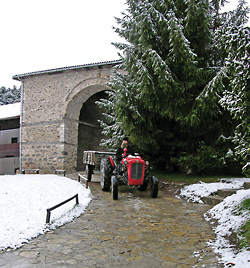 Early morning, the tenth in November. We open the window of Lenotije’s quarters and see with surprise: after an evening and night of rain, Visoki Dečani dawns under snow. The atmosphere in the monastery is already lively. While we hurriedly take pictures with the blessing of Bishop Teodosije, the singing from the morning service follows us. Ison, that murmur of the heavenly, spread beneath everything, ascends high. From the bell tower, we see a young monk going to fetch water. Immediately across the Dečani Bistrica, only about a hundred meters from the Monastery, there is a natural spring of excellent, mildly mineral water. Moving without armed escort is allowed to Bistrica, about fifty meters from the Monastery wall. Only a step further, escort is obligatory. Therefore, an Italian soldier follows every step of the monk, with his weapon ready. Each time, every day, for each plastic can of water. Early morning, the tenth in November. We open the window of Lenotije’s quarters and see with surprise: after an evening and night of rain, Visoki Dečani dawns under snow. The atmosphere in the monastery is already lively. While we hurriedly take pictures with the blessing of Bishop Teodosije, the singing from the morning service follows us. Ison, that murmur of the heavenly, spread beneath everything, ascends high. From the bell tower, we see a young monk going to fetch water. Immediately across the Dečani Bistrica, only about a hundred meters from the Monastery, there is a natural spring of excellent, mildly mineral water. Moving without armed escort is allowed to Bistrica, about fifty meters from the Monastery wall. Only a step further, escort is obligatory. Therefore, an Italian soldier follows every step of the monk, with his weapon ready. Each time, every day, for each plastic can of water.
Today is the day of St. Arsenije Sremac, the day when the Church mentions the Archbishop who, chosen by St. Sava, succeeded him and moved the seat of the Serbian Archbishopric from Žiča to Peć. The Patriarchate, about fifteen kilometers from here, celebrates. ”Everyone will be there”.
All Serbs are also exiled from Peć, the main Metohija town. All to the last one. The Patriarchate is not in solitude, not surrounded, but under a kind of siege, silent and threatening. It was a long fight for building a new protective stone wall around the Monastery complex, over three meters high, so that the level of safety of the besieged sanctity and the sisterhood in it would at least be a little higher. The local Albanian authorities did everything to prevent the construction of the wall, but luckily, only managed to slow it down and make it more expensive.
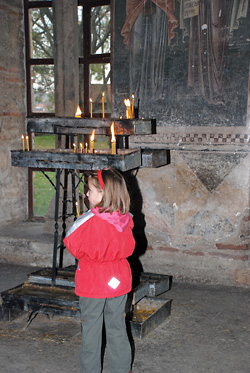 The first snow turned the entrance to the Rugova Gorge into white. It seems that the Peć Bistrica is roaring even more today. We pass through Peć, then the control point at the external gate, and arrive to the very entrance of the Monastery. The severe safety measures conducted by the Italian soldiers at the access to the Patriarchate, measures for which the Church and the sisterhood are grateful, additionally emphasize the feeling of besiegement. The holiday liturgy in the Holy Apostles Church, the central temple of the Patriarchate of Peć, is solemn and sad. Solemn, as always on holidays; sad, as always when there is no freedom. Surprisingly and encouragingly, there are many people in the temple. They arrived from all parts of Serbia, Srpska, Montenegro. The Liturgy is served by the Episcope of Budimlje and Nikšić Joanikije and the Vicar Episcope of Lipljan Teodosije. The first snow turned the entrance to the Rugova Gorge into white. It seems that the Peć Bistrica is roaring even more today. We pass through Peć, then the control point at the external gate, and arrive to the very entrance of the Monastery. The severe safety measures conducted by the Italian soldiers at the access to the Patriarchate, measures for which the Church and the sisterhood are grateful, additionally emphasize the feeling of besiegement. The holiday liturgy in the Holy Apostles Church, the central temple of the Patriarchate of Peć, is solemn and sad. Solemn, as always on holidays; sad, as always when there is no freedom. Surprisingly and encouragingly, there are many people in the temple. They arrived from all parts of Serbia, Srpska, Montenegro. The Liturgy is served by the Episcope of Budimlje and Nikšić Joanikije and the Vicar Episcope of Lipljan Teodosije.
”We are gathered here today due to our two spiritual fathers, two of our great people, mutually permanently bonded: St. Sava and St. Arsenije”, spoke Bishop Joanikije in the temple. ”St. Sava is also great because he succeeded in leaving after himself, as his successor, a holy man, the second Archbishop of Serbia and founder of this holy community. The time of St. Arsenije, as it is today, was difficult for the Serbian people in the stormy Balkans. The enemies of the cross and Orthodox faith then also desolated Serbia several times, therefore the seat of the Serbian Archbishopric was moved here, under these mountains, to this hidden place… We are all, of course, worried about everything happening in these Serbian lands, especially here, in Kosovo and Metohija. We are worried about the survival of our people and our sanctities. In these worries, our Orthodoxy and Christ’s Gospels encourage us and give us hope, give us faith, resolute and indestructible. Especially in this place, one the holiest ones for the Serbs, beside the graves and bones of our holy patriarchs and archbishops, where we receive and renew the strength derived from the Throne of God, confirming our mutual communion.
Here is where our heart is, and here we must continue gathering… And may God give us better times, so we could at list live more freely, breathe and walk more easily. We are used to suffering, we shall endure this too.”
THE MOMENT FOR SEWING TOGETHER 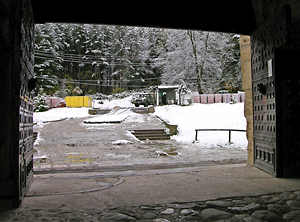 Even the Albanians don’t drive down the road Peć – Kosovska Mitrovica, passing by Istok and Srbica, after seven in the evening. Typical are road bandits’ attacks, robberies, rapes, murders. Europe Now. Hence, we cannot attend the lunch at the Patriarchate and set off down that road during the day. Vitomirica, Dobruša, Djurakovac, Rakoš, Rudnik… There are no Albanian toponyms here (like in the whole Kosovo and Metohija), because they actually don’t exist. Their names in Albanian, starting with the name of Kosovo or Metohija, are only transcriptions of Serbian names. These words don’t mean anything in Albanian, they don’t have a root, a meaning, symbolism. They manage to camouflage it before themselves somehow, but especially avoid the name Metohija. We know, this word in Serbian means church property, monastery estate, and clearly indicates whose land it is. Even the Albanians and their media consultants couldn’t manage to fit this into their story somehow. Even the Albanians don’t drive down the road Peć – Kosovska Mitrovica, passing by Istok and Srbica, after seven in the evening. Typical are road bandits’ attacks, robberies, rapes, murders. Europe Now. Hence, we cannot attend the lunch at the Patriarchate and set off down that road during the day. Vitomirica, Dobruša, Djurakovac, Rakoš, Rudnik… There are no Albanian toponyms here (like in the whole Kosovo and Metohija), because they actually don’t exist. Their names in Albanian, starting with the name of Kosovo or Metohija, are only transcriptions of Serbian names. These words don’t mean anything in Albanian, they don’t have a root, a meaning, symbolism. They manage to camouflage it before themselves somehow, but especially avoid the name Metohija. We know, this word in Serbian means church property, monastery estate, and clearly indicates whose land it is. Even the Albanians and their media consultants couldn’t manage to fit this into their story somehow.
In our field of vision, on this road, a church stands only in Djurakovac, in the center. With broken windows, in a completely desolated yard, but it still stands. Touchingly beautiful, in spite of everything.
Mokra Gora and Suva Planina are on the left, on the right is ”Srbica without Serbs”, and in its proximity is the heavily damaged monastery of Devič, endowment of Djuradj Branković, raised as a sign of gratitude to St. Joanikije of Devič, who healed his daughter in these woods. Not far is Banja Rudnička, a village where protovestiar Rodop gifted the famous bell to St. Nicholas Church in the XV century. The silent bells of Metohija. Bells which, buried in difficult times of invasions and plunderings, suddenly appeared in even more difficult times and presented themselves as illuminations.
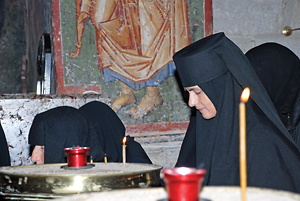 The road is deserted already from the turn towards Istok. A beautiful landscape, but immersed into silence, just like us. Yes. It seems neither threatening, nor sad, nor lifeless. Only immersed into silence. Into waiting? That ”Srbica area” and ”Northern Drenica” were the stronghold of UCK. People here remember many crimes of this organization committed against the Serbs, but also against Albanians. That is why today every alley, every crossing, the center of every village, every fountain, every cooperative home, are all marked with monuments glorifying the members of UCK and producing a false history. The ones who place them obviously know that, in the Balkans, such as they are, the chances of real against false history are 50:50. Although they haven’t won a single significant battle, although they were completely marginal in the military sense, and reduced their ”warfare” to road ambushes and robberies, whose victims were both Serbs and numerous Albanians, the conceited glorious warfare of UCK is today ”marked” by more monuments than the monuments raised to Partisans in the communist Yugoslavia. The road is deserted already from the turn towards Istok. A beautiful landscape, but immersed into silence, just like us. Yes. It seems neither threatening, nor sad, nor lifeless. Only immersed into silence. Into waiting? That ”Srbica area” and ”Northern Drenica” were the stronghold of UCK. People here remember many crimes of this organization committed against the Serbs, but also against Albanians. That is why today every alley, every crossing, the center of every village, every fountain, every cooperative home, are all marked with monuments glorifying the members of UCK and producing a false history. The ones who place them obviously know that, in the Balkans, such as they are, the chances of real against false history are 50:50. Although they haven’t won a single significant battle, although they were completely marginal in the military sense, and reduced their ”warfare” to road ambushes and robberies, whose victims were both Serbs and numerous Albanians, the conceited glorious warfare of UCK is today ”marked” by more monuments than the monuments raised to Partisans in the communist Yugoslavia.
While driving towards Gornja Klina and Trnavci, we see the Čičavica mountain in the east. Some of the biggest Serbian police and military operations against the terrorist formations were performed there.
We soon enter the southern part of Mitrovica, and then cross the Ibar. A car with Belgrade plates and the road towards the north is waiting for us there.
We traveled through Kosovo and Metohija lengthwise and crosswise, with a deep and clear feeling that we are walking upon our own country. Homeland. And? After that, one feels more dignified and more of a human. We watch the landscapes, this earth and this sky, those cities and temples, those people, sort the memories, and some unusual peacefulness fulfils us. We know that we will come back. However arrogant, brutal, senseless, exclusive it may seem, the bashi-bazouk also knows it. It knows it with its unmistakable cowardly heart, which, in a male fight, exactly ten years ago, couldn’t last longer than a month and a half. It wouldn’t last now either. That is why they so desperately need Serbian consent that we will go back there again. That is why they will never get it.
Two different times are before the Serbs and the Albanians. Each must live through its own.
Until the time for sewing together comes.
***
The Wounded Temple
About fifteen kilometers before Peć, on the right side of the Metohija motorway, in a place with an erased name, in the decomposed church yard, lay the remains of one among more than one hundred and fifty destroyed Serbian churches. Ruins. The temple was obviously mined, everything is destroyed, collapsed, only the tower remained whole. It fell to the ground, but didn’t break. That unbroken tower, in the tall grass, about ten steps from the ruin, like a wounded but alive hero who remained at the battlefield to die slowly, alone, will be one of the images which will remain with us forever after this journey. We wanted to stop, to enter the ruins, to take pictures, to take a piece of that wounded temple, but were warned that it would be irrational. The ones who destroyed it live in the immediate proximity and, unlike us, are completely under arms.
*** Candles and Liberators
In the formal hall of the Dečani Dining Room, a young monk Petar, originally form Podgorica, shows us two large ornamented candles, over two meters high. Princess Milica, wife of holy prince Lazar, gifted it to the Monastery probably in 1397, when she visited Dečani with her sons Stefan and Vuk, with a pledge that the candles should be lighted by the liberators of Kosovo. Aleksandar I Karadjordjević was the first to light them in 1924, when he visited the Monastery.
Who will light them for the second time?
*** Making up Heritage
Calmly, impartially, without any prejudice, go through the cultural and any other history and heritage of Kosovo and Metohija, study the findings, artifacts, scientific material, localities, edifices. Perform the most voluminous field studies. You will find prehistoric, antique, Roman, Byzantine, Ottoman heritage, and by far most from the Serbian golden medieval age. Only one thing you will not find, not even in traces: the Albanian cultural heritage. Therefore, their parallel-state bodies embark in tragicomic forgeries, such as the recent one at the Tourism Fair in Ohrid (Bishop Teodosije writes about it in this issue of the National Review). Sometimes it seems that the formula is vulgarly simple: destroy everything and then proclaim it your own lost heritage. Establish equity in having nothing.
|
